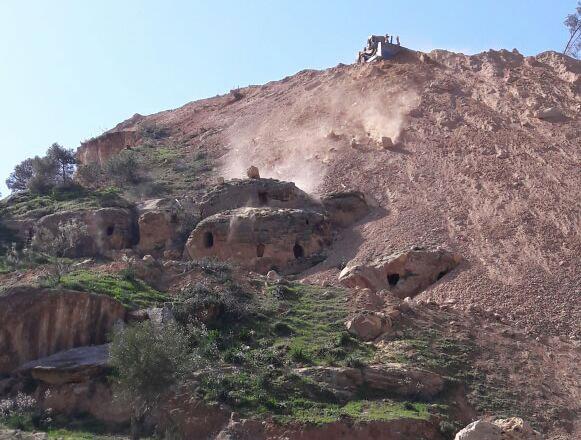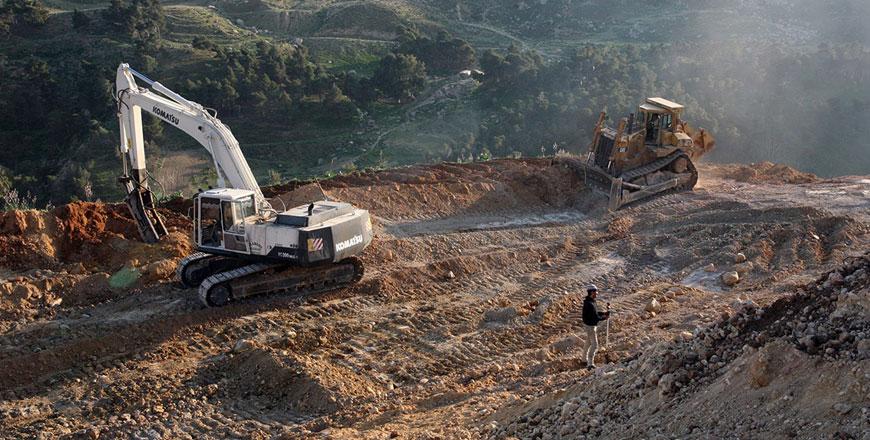You are here
Authorities urged to preserve Jerash-Bronze Age caves from bulldozers
By Ahmed Bani Mustafa - Mar 12,2017 - Last updated at Mar 12,2017

Road construction work under way near caves in Jerash on Amman Irbid-Highway recently (Photo courtesy of Yousef Zuraiqat)
Jerash — The Director of the Old Testament Centre Yousef Zuraiqat on Saturday urged the authorities to protect ancient caves at risk of destruction or burial by roadworks near Jerash, 45km north of Amman.
The Ministry of Public Works and Housing has started reconstruction work on the Jerash section of the Irbid-Amman highway after a landslide blocked the road in January, forcing authorities to reroute traffic through a temporary detour.
Bulldozers used by the ministry’s contractors were seen by local residents “destroying or burying caves” thought to date from the Bronze Age.
The caves are located next to the highway, where the recent landslide destroyed part of the street and forced authorities to plan a detour that will inevitably lead to the burial of some of the caves.
Zuraiqat told The Jordan Times that the tombs, dating back Bronze Age or 4,000 BP, were seen being “buried by bulldozers” being used to construct the new detour.
The caves could be detached, cut into small parts and reassembled at museums or universities for exhibition, Zuraiqat suggested, adding that they represent part of Jordanian heritage and identity.
Ahmed Melhem, Jerash’s antiquities director, said that although all ancient structures are precious and important, avoiding the caves, which are not unique as they are not connected to an important historic event, would delay the urgently-needed detour on the vital road and would cost millions, which could be used in other projects of higher archaeological importance to the ancient city of Jerash.
Melhem said he appreciated residents’ understanding of the situation, with the ministry working to secure a pivotal road that connects the Kingdom’s two biggest cities.
He pledged that, in addition to documenting the structures, the directorate will spare no effort in relocating some of the caves if technically possible.
Humans in Jordan have used and reused caves since the Epi-Paleolithic Era (12,500 BC), Omar Ghul, an associate professor at Yarmouk University’s faculty of archaeology, told The Jordan Times in a phone interview.
He said that nobody can belittle the importance of any ancient cave, even if there are thousands of them in the Kingdom.
He added, however, that if their preservation will compromise people’s safety and time in addition to wasting public funds, there is no choice other than to document and then bury them.
Commenting on the possibility of relocating the possibly human-made caves, Ghul and Melhem said that it would be technically impossible as they are cut from rock, attached to the mountain, large and not free-standing buildings, while adding that the caves are not worth risking anyone’s life to preserve.
Former director of Jerash Antiquities Directorate Aida Noghway said that the mountain’s rock is fragile as it is sandstone, which puts the caves at risk of collapse, now or in the future, and leaving them does not mean they will stay there forever.
The site has been documented since the 1990s, Noghway said, citing an Italian archaeologist’s survey that was conducted at the time of the highway’s initial construction.
On Saturday, Public Works Minister Sami Halaseh visited the site of the landslide and inspected work on the detour, saying that the deadline for finishing the work is 70 days in normal weather conditions, the Jordan News Agency, Petra, reported.
The current temporary detour is causing traffic congestion because it had to be completed in 48 hours, the minister said, adding that last week’s congestion was caused by an accident when a truck overturned.
Related Articles
AMMAN — The Ministry of Public Works and Housing on Tuesday said it has started the reconstruction work of the Jerash-Amman highway, where a
AMMAN — Jerash Public Works Director Akram Khasawneh on Thursday announced that traffic on the road connecting Amman and Irbid can now conti
AMMAN — The rehabilitation of the Jerash-Amman highway, which is currently damaged due to a landslide, needs about 60 to 70 working days in












